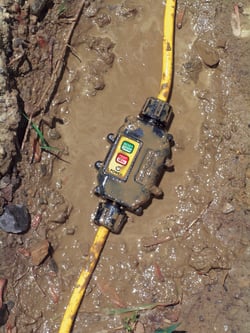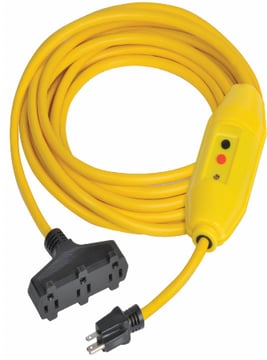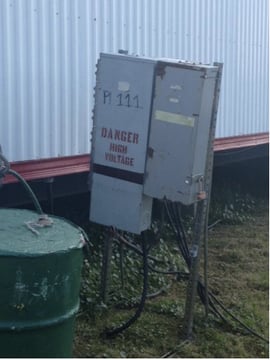Ground Fault Circuit Interrupters are complex devices that protect people and equipment every day in difficult work environments. Whether it is due to water or damaged equipment, ground faults can occur easily and quickly. If these are not fixed right away, they can result in severe injury or electrocution. We understand GFCIs and how they work in your industry to promote electrical safety. The information provided here will help you understand the differences between automatic and manual GFCIs. The GFCI terms “auto” and “manual” have been in the electrical industry for years, but they have been confusing to many as to the functionality of the GFCI. These terms often refer to the operation of the GFCI when first plugged into a voltage source. Contrary to what some people think, these terms have nothing to do with the “tripping and subsequent resetting” of the GFCI. In general, there are two main events for a GFCI: (1) Power-up mode and (2) Trip and reset mode. Power-up mode refers to the condition of the GFCI after being plugged into a correct voltage source.
We understand GFCIs and how they work in your industry to promote electrical safety. The information provided here will help you understand the differences between automatic and manual GFCIs. The GFCI terms “auto” and “manual” have been in the electrical industry for years, but they have been confusing to many as to the functionality of the GFCI. These terms often refer to the operation of the GFCI when first plugged into a voltage source. Contrary to what some people think, these terms have nothing to do with the “tripping and subsequent resetting” of the GFCI. In general, there are two main events for a GFCI: (1) Power-up mode and (2) Trip and reset mode. Power-up mode refers to the condition of the GFCI after being plugged into a correct voltage source.
The AUTO or “AR” versions of these GFCI are NOT AUTO RESET. The term "reset" has been linked to the GFCI line inadvertently. The original naming scheme was to show the AUTO power-up operations with reset. The manual versions were named to show MANUAL power-up operation with reset. There is no such thing as an automatic resetting GFCI. This would be like a self-healing fuse. It is illegal, against safety codes and human protection to design and sell a GFCI that can automatically reset itself after tripping under a fault condition.
Now let’s discuss the difference between automatic and manual GFCIs.
Automatic
The “auto” GFCI will immediately energize the relay and allow protected voltage to be available at the load side of the GFCI. This GFCI has automatically powered-up and is ready for use without the assistance of pressing any buttons. This is similar to a Plug and Play GFCI.
Manual
On the “manual” GFCI, the "reset" button has a dual role in functionality. First, the button helps power-up the unit. Secondly, the button helps the GFCI reset after a fault. The “manual” GFCI operates slightly different from the automatic, as it requires someone to press the “reset” button (which is operating as a power-up button on this unit). This allows the GFCI to close the relay and operate as required.
At Ericson, we are experts in electrical safety on job sites. Contact us if you have any questions.
Tag(s):
Workplace Safety
Marlo Miller
Marlo Miller is the Inside Sales Representative for the Central Region at Ericson Manufacturing. She holds a degree in Pastry Arts & Science from the International Culinary Arts & Science Institute and has 10 years of industrial distribution experience. She enjoys sports and being a mama to her daughters.
More from the blog
View All Posts
Workplace Safety
3 min read
| October 28, 2016
6 Ways a Manufacturer of Electrical Safety Products Can Save You Money
Read More
Certifications and Regulations
1 min read
| May 5, 2021
May 5, 2021 - UL 943 Code
Read More.png?length=360&name=MicrosoftTeams-image%20(45).png)
Certifications and Regulations
4 min read
| March 12, 2024
Updated UL943-5th Edition and UL1640 Code effects on In-Line GFCI Cordsets
Read MoreSubscribe to blog updates
Stay up-to-date on what's happening at this blog and get additional content about the benefits of subscribing.
